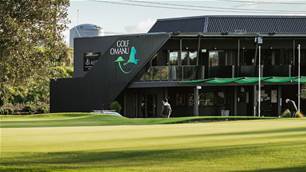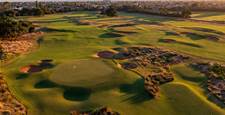The approach to Cypress Lakes leaves you in no doubt that you’re in hardcore wine country.
It’s hard to escape the references – it’s probably the reason that you’ve come to the Hunter Valley, after all – the approach to Cypress Lakes leaves you in no doubt that you’re in hardcore wine country.
Vineyards and cellar doors with those oh-so esoteric label names dot the landscape, luring out its own kind of devotees to go from one to the next, as surely as they were going from tee to fairway to green.
The references don’t stop when you arrive at Cypress, which is noted not only for its golf course but as the site of the Golden Door Spa. There’s a cellar door hard by the 9th tee, and all the tee markers are in the shape of wine bottles. There are vines around the layout, not exactly hazards but neither places you want to hit into, and the course itself has its own wine.
In keeping with the theme, the golf at Cypress Lakes is best sipped rather than quaffed. The course was designed by American Steve Smyers, a Florida-based architect and high-level competitive amateur who has recently held several senior positions with the United States Golf Association’s executive committee. While much of his work is based in the United States, and Cypress Lakes remains his only Australian design, Smyers has travelled extensively around the golf world, and his Australian wife Sherrin is a former LPGA Tour pro. These broader horizons helped instil in Smyers an affinity for the qualities of classic, ground-game golf, like that found on British links and the Melbourne Sandbelt.
At Cypress, he was able to turn what was a challenging site to build on and a drawn-out construction process into a good example of strategic golf. With each nine boasting a distinct character – the outward half is relatively treeless, open and rolling, where the inward is more defined, with sharper falls and rises as it winds its way below the high point of the resort – the course contains a variety of hole types, from drive-and-pitch par-4s and reachable par-5s to stern, long par-3s and what was, at one point, the longest golf hole in the land. In every case, position is paramount, with golfers presented with the task of plotting rather than blasting – again, sipping, not quaffing.
For those whose last visit to Cypress Lakes was a while back, as it was for your reviewer, the first notable difference is the change to the order of the course. The round used to open on a crescent-shaped par-5, not too long at 450 metres max but markedly uphill, and the drive had to clear a large water hazard. It was a tough way to start, particularly for the resort visitors indulging in a hit, and clogged pace-of-play from the outset.
The course still opens on a curving, reachable par-5, what was the former 10th, and as such the old front and back nines have been inverted (it used to be parkland nine first, open nine second). A deep channel bisects the hole and will catch the longer drives, but it’s a scoring chance at two or three shots into the green.
The 2nd brings back the touch of oenophilia. Without much fairway in view, the drive has to carry the vines of the Brokenwood Graveyard Winery, where they grow one of the most admired Shiraz in the country. The main considerations on the approach are all to the left: a small bunker, and a larger water hazard, that are bad news for any errant pull.
The 3rd and 4th shape as the round’s first tough spot, with a long, well-bunkered one-shotter followed by a very long par-4 (439 metres from the tips), with out-of-bounds down the right and one of the more impressive green sites on the layout. The 5th is the scene of another substantial change – formerly a dramatically uphill par-3 with a don’t-be-short front, the hole has been turned into a 260-metre par-4, with the tee stretched back alongside a water hazard. The new hole will certainly provoke debate, even if it’s hard to find many golfers who admit to liking uphill par-3s. One thing that commends this hole, however, is even after a layup, the second is no gimme – off an upslope, sometimes with no view of the putting surface.
The vines reappear at the par-5 6th, whose fairway swoops down from the tee and back up again to the green. After a brace of drive-and-pitch par-4s at the 7th and 8th – where it must be noted that your reviewer made what must be one of the luckiest birdies the game, or more accurately, one of my playing partners, has ever seen – the front nine closes out on a tough par-4, the no.1 index hole. It’s a long hole, but position on the drive here is just as important as length, with a single gum in the left half of the fairway defining the line in. The 9th marks the change of the character in the course from the open landscape to the parkland style, as a thick strand of trees frame a narrow, back-to-front sloping green.
The 11th is a picture par-3, no more than 140 metres over a dip to a shallow green, formerly distinguished by a sharp ridge in the middle. That has since been flattened, but the steep bulkhead left – maybe a good 20 feet down – has not changed.
Like the 5th, the 12th has come in for change. This was one of the memorable holes of the course, for the fact you were likely to lose balls as much as anything. It was a long par-4, 400 metres even from the visitor plates, with a drive coming out of a narrow chute to what appeared to be a sliver of fairway – in reality, three tiers of short grass which widened as you went right. It’s been re-formulated as a par-3, played downhill from the highest point of the fairway, turning it into a long one-shotter that’s still plenty difficult.
The old 1st arrives now at the 14th, a better place in the round for such a hole. The long hitters might find it reachable after a good drive, but they’ll be made to think about laying up, with the slope at the front of the two-part green unlikely to allow anything to roll in.
At the next par-5, there’s no choice to be made. The 16th is three shots, at least, for almost everyone, a hole that once measured more than 600 metres, and now checks in a not-so-meagre 573 metres. If that wasn’t enough, the drive is blind, played over a rise about 200 metres from the tee. A scheme of bunkers sits about 150 metres out – if your second shot makes it that far – and any right-side hole location bring a big front bunker into play.
The finisher is a strong par-4, calling for a drive to the right half of the fairway short of a big bunker. The green sits in something of an amphitheatre, a small target that slopes from the back.
The finisher is a strong par-4, calling for a drive to the right half of the fairway short of a big bunker. The green sits in something of an amphitheatre, a small target that slopes from the back.
Variable weather in the Hunter in recent times has presented challenges for the conditioning at Cypress Lakes, but prospects are improving. The course retains a good balance of playability and challenge, something that has served it in its most high-profile role, when it hosts the Jack Newton Celebrity Classic. And even for the beer drinkers out there, there’s something neat about a golf course that has its own wine to go with the round.
THE COURSE
LOCATION: Thompsons Rd, Pokolbin, in the Hunter Valley, an hour’s drive from Newcastle and a little over two hours’ from the centre of Sydney.
CONTACT: (02) 4993 1800.
WEBSITE: www.cypresslakes.com.au
DESIGNERS: Steve Smyers and Bob Stanton (1994).
PLAYING SURFACES: Wintergreen couch fairways, Penncross bent and Poa Trivialis greens.
BUNKERS: 60.
PGA PRO: Kieran McMahon.
GREEN FEES: Monday-Thursday $75 AM, $65 PM; Friday-Sunday $90, Sunday PM $80.
THE CLUB
MEMBERSHIPS: Cypress Lakes offers a variety of individual, family and corporate membership options. Members also have access to a range of discounts from the resort.
CORPORATE AND GROUP DAYS: The club’s events team can organise every aspect of a corporate golf day, with a range of services that includes on-course wine tasting and themed lunches. The resort can also handle extensive conference operations with its convention centre and accommodation. There are also a range of special deals for groups of 16 or more, including the “one in five” free round offer.
FACILITIES: The course is the centre of a well-established Hunter Valley resort that offers villa accommodation, restaurants and bars as well as the Golden Door Spa and the Brokenwood Wines cellar door. The country club also has tennis courts, pools, kids club, gym and luxury change rooms.
AWARDS: Ranked No.72 in Golf Australia Magazine’s Top-100 Public Access Courses.
Related Articles

Review: Omaha Beach Golf Club

Drinks With... Ricky Ponting









_15th_hole.jpg&h=115&w=225&c=1&s=1)




